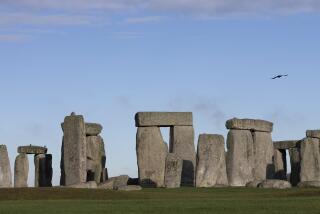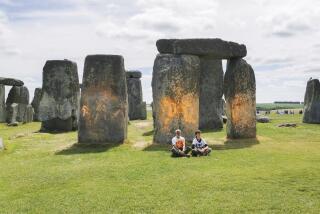Summer solstice 2013: Marking longest day at eeriest ancient sites
- Share via
The summer solstice has arrived, and Google has marked the occasion with an animated doodle of ocean swimmers leisurely lifted by waves. Meanwhile, scientific types will pause to appreciate the phenomenon of the longest day of the year in the Northern Hemisphere.
And those with a little romance in their souls will look to the ancient sites where sun and stones align and perhaps get a few goosebumps. Stonehenge, for example, remains a modern-day mystery. The circle of standing stones drew a mixed crowd of 20,000 people on Friday.
How was Stonehenge built, and why? The stones are aligned with the rising of the sun at the summer solstice.
Some experts say the prehistoric monument, located on England’s Salisbury Plain, is aligned with the sun because it was built by a sun-worshiping culture. As BBC News reported in 2008, radiocarbon dating placed the erection of the first “bluestones” in the structure at 2300 BC. Still others contend that Stonehenge was part of a huge astronomical calendar.
The sun didn’t cooperate on Friday at Stonehenge, where dawn was overcast. The crowd of attendees included druids who were looking to worship as well as folks who had overimbibed looking to party. As the Associated Press noted, the solstice usually brings in a large, varied crowd to the mysterious standing stones.
London’s Guardian reported a large number of pagans making a pilgrimage to the site, including Arthur Pendragon, head of the druidic order the Loyal Arthurian Warband. Pendragon, who wore long white robes, “called for peace in the east, west, north and south.” Another attendee wasn’t pagan but did admit to having had alcoholic refreshment and smoking “something a bit herbal.”
Meanwhile, in the Republic of Macedonia, the Bronze Age site Kokino drew visitors to its megalithic observatory. The site, on the tentative list for UNESCO World Heritage status, includes four stone seats, or thrones, and markers that correspond to the position of the rising sun at the summer and winter solstices.
The summer solstice annually draws visitors to other ancient sites around the world. Here, a few examples:
Serpent Mound, Ohio
The ancient earthwork is in the shape of a snake. The head of the serpent faces the summer solstice sunset. Near Serpent Mound, along the Ancient Ohio Trail, can be found other earthworks as well as the site of a giant “woodhenge,” the Moorehead Circle, where stains in the soil have indicated a 200-foot-diameter circle.
Ancient sites in Egypt
At the summer solstice, the sun sets between two grand pyramids when viewed from the Sphinx. The setting sun also intersects Egypt’s ancient Osireion temple and lights up the altars at Qumran.
Pyramids of Guimar, Canary Islands
The six pyramid-shaped, terraced structures are on the island of Tenerife. At summer solstice, when viewed from the platform of the largest pyramid, a double sunset appears to occur -- the sun sets behind a mountaintop, emerges from behind the mountain and sets again behind a nearby peak.
ALSO:
May global temperature ties third-warmest on record
Penguin-shaped galaxy and one that looks like an egg
Warming oceans could kill ‘Hoff,’ the David Hasselhoff crab







